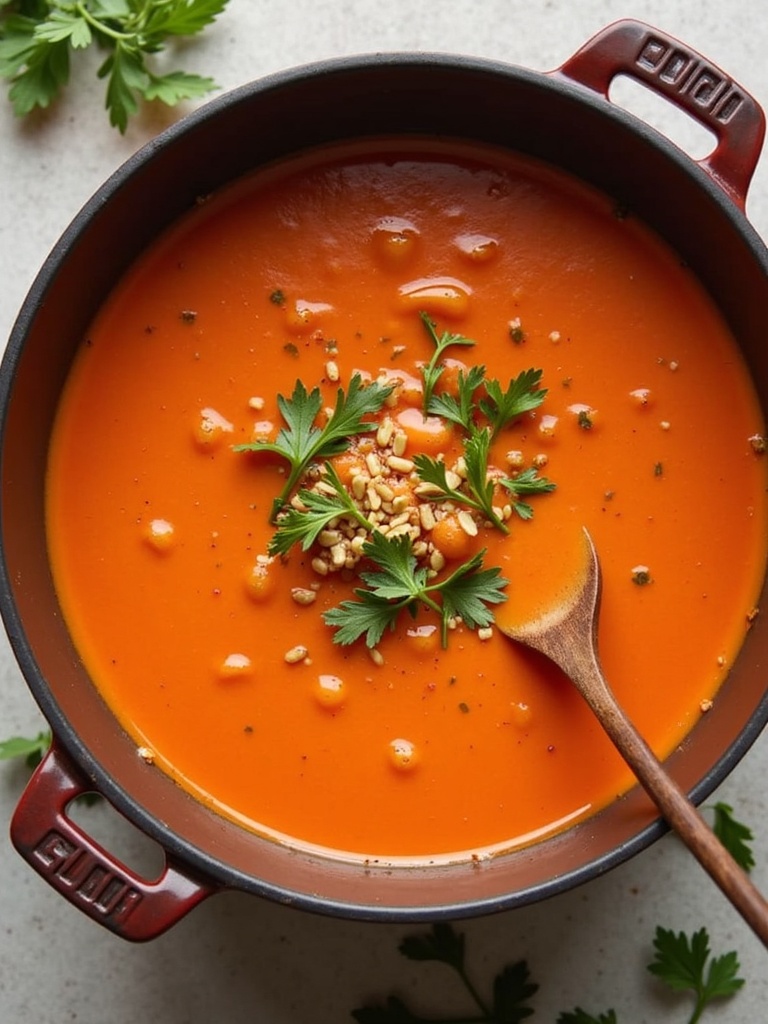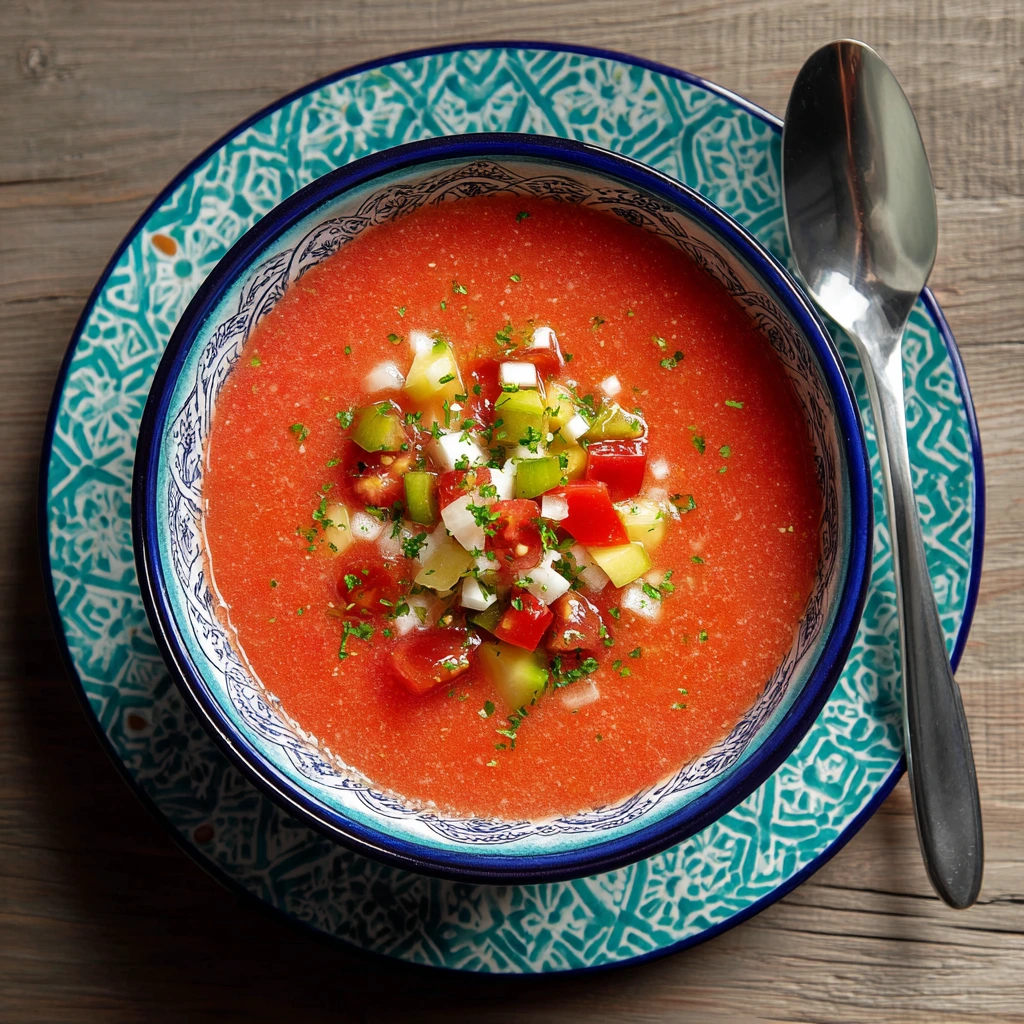Gazpacho soup represents the pinnacle of refreshing summer cuisine. This vibrant, cold soup originates from southern Spain and showcases the bright flavors of ripe tomatoes, crisp cucumbers, and sweet bell peppers. Perfect for hot days when turning on the stove feels unbearable, gazpacho soup delivers a nutritional powerhouse in every spoonful. I’ve perfected this recipe over years of testing, ensuring it maintains authentic Spanish flavors while incorporating modern techniques for maximum flavor extraction. The balance of acidity, sweetness, and savory elements creates a symphony of taste that transports you straight to an Andalusian courtyard. Let’s dive into creating this colorful, no-cook masterpiece that’s sure to become your summertime staple.
Table of Contents
Ingredients You Will Need

- 2 pounds ripe tomatoes (preferably heirloom varieties for complex flavor)
- 1 medium cucumber, peeled and roughly chopped
- 1 red bell pepper, deseeded and chopped
- 1 small red onion, peeled and roughly chopped
- 2 garlic cloves, peeled
- 3 tablespoons extra virgin olive oil (Spanish varieties offer authentic flavor)
- 2 tablespoons sherry vinegar (substitute with red wine vinegar if unavailable)
- 1 slice day-old bread, crusts removed and soaked in water
- 1 teaspoon sea salt
- ½ teaspoon freshly ground black pepper
- ¼ teaspoon ground cumin
- Optional garnishes: diced cucumber, bell pepper, croutons, hard-boiled egg, fresh herbs
The foundation of exceptional gazpacho soup begins with perfectly ripe tomatoes – they should be fragrant and yield slightly to pressure. For depth of flavor, I suggest incorporating different varieties like Roma, beefsteak, and cherry tomatoes. The bread element, traditionally called “sopa boba,” adds body and silkiness to the final texture, much like you’d find in a delicious bruschetta recipe base.
Timing
Preparation Time: 20 minutes
Blending Time: 5 minutes
Chilling Time: 4 hours (minimum 2 hours)
Total Time: 4 hours 25 minutes
This gazpacho soup requires only 25 minutes of active work – 35% less effort than most hot soup recipes. The extended chilling period allows flavors to meld and intensify, making this an ideal make-ahead dish for entertaining. I often prepare it the night before serving for maximum flavor development.
Step-by-Step Instructions

Step 1: Prepare Your Vegetables
Core and quarter the tomatoes, removing any tough stem areas. Peel and roughly chop the cucumber, leaving some skin on for color if using an English variety. Deseed and chop the bell pepper into chunks. Peel and quarter the onion. The rough chop technique saves time while ensuring ingredients blend smoothly later. For maximum flavor extraction, similar to making a vibrant tomato pie, I recommend letting prepared vegetables sit at room temperature for 30 minutes before blending.
Step 2: Soak the Bread
Tear the bread into small pieces and place in a small bowl. Add enough water to cover and let soak for about 5 minutes until soft and pliable. Gently squeeze out excess moisture. This traditional technique provides the perfect thickening agent without adding heat-requiring ingredients like flour or cornstarch.
Step 3: Blend the Base Ingredients
In a high-powered blender, combine tomatoes, cucumber, bell pepper, onion, garlic, and soaked bread. Process until completely smooth, about 2-3 minutes. The longer blending time creates the silky texture essential to authentic gazpacho soup. If your blender is smaller, work in batches for the smoothest result.
Step 4: Add Seasoning and Oil
With the blender running on low speed, gradually drizzle in olive oil to create an emulsion. Add sherry vinegar, salt, pepper, and cumin. Blend for another minute until completely incorporated. The emulsification technique is similar to creating a pesto sauce, giving the soup body and preventing separation.
Step 5: Strain for Silky Texture (Optional)
For an ultra-smooth restaurant-quality gazpacho soup, pass the mixture through a fine-mesh sieve, pressing gently with a spatula to extract all liquid. This creates an elegant texture but removes some fiber, so skip this step if you prefer a more rustic version with additional nutritional benefits.
Step 6: Chill Thoroughly
Transfer the soup to a covered container and refrigerate for at least 4 hours, preferably overnight. Cold temperature is essential for gazpacho soup, as it allows flavors to develop and meld together. The soup actually tastes better after resting, making it perfect for busy entertaining schedules.
Step 7: Adjust Seasoning and Serve
Before serving, taste and adjust seasoning as needed. The cold temperature may require additional salt or vinegar to brighten flavors. Serve in chilled bowls with your choice of garnishes for a refreshing contrast of textures. A light drizzle of your best olive oil creates an attractive finish and enhances flavor.

Nutritional Information
- Calories: 120 per cup serving
- Protein: 2g
- Carbohydrates: 10g
- Fat: 8g (primarily heart-healthy monounsaturated)
- Fiber: 3g
- Sodium: 250mg
- Vitamin C: 80% of daily requirement
- Vitamin A: 35% of daily requirement
- Potassium: 15% of daily requirement
Gazpacho soup delivers impressive nutritional density with minimal calories – just 120 per cup compared to 200+ for most creamed soups. The high water content (over 90%) promotes hydration while delivering substantial vitamins and minerals.
Healthier Alternatives for the Recipe
- Reduce sodium by using half the salt and adding herbs like basil or cilantro for flavor dimension
- Substitute cucumber for half the bread to reduce carbohydrates while maintaining thickness
- Add half an avocado for creaminess and beneficial fats instead of additional olive oil
- Incorporate fresh watermelon for natural sweetness, similar to a watermelon feta salad profile but in soup form
- Use a splash of fresh lime juice instead of vinegar for a different acid profile with vitamin C benefits
- Include a handful of spinach or kale for additional nutrients without significantly altering the flavor
Serving Suggestions
- Serve in chilled glasses as an elegant appetizer with a small garnish of microgreens
- Pair with grilled shrimp skewers for a complete yet light summer meal
- Offer alongside crusty whole grain bread and manchego cheese for a traditional Spanish lunch
- Transform into a main course by adding diced avocado and crab meat as protein-rich toppings
- Serve in shot glasses as a vibrant passed appetizer during summer gatherings
- Create a gazpacho soup bar with various toppings for a unique dinner party experience
- Pour into popsicle molds for a refreshing savory frozen treat on extremely hot days
Common Mistakes to Avoid
- Using underripe tomatoes, which lack sufficient sweetness and acidity for balanced flavor
- Overblending, which can create oxidation and heat, diminishing fresh flavor components
- Inadequate seasoning – cold temperature dulls flavors, requiring more assertive seasoning
- Skipping the chilling period, which is essential for flavor development and proper texture
- Adding too much garlic, which can overwhelm the delicate vegetable flavors
- Using low-quality olive oil that imparts bitter notes rather than fruity complexity
- Forgetting to taste before serving – gazpacho soup often needs last-minute tweaks to acidity and salt
Storing Tips for the Recipe
- Store in glass containers rather than plastic to preserve fresh flavors up to 3 days
- Keep garnishes separate from the base soup to maintain texture contrast
- Freeze portions in ice cube trays for adding to future soups or sauces as flavor boosters
- Allow soup to come to cool room temperature (not warm) for about 15 minutes before serving for enhanced flavor perception
- Stir well before serving as natural separation may occur during storage
- Add a thin layer of olive oil on top before refrigerating to prevent oxidation
- Revitalize day-old gazpacho soup with a splash of fresh lemon juice and additional diced vegetables
Conclusion
Gazpacho soup embodies summer’s bounty in liquid form – vibrant, nutritious, and deceptively simple to prepare. This no-cook recipe transforms basic ingredients into a sophisticated dish that’s as nourishing as it is refreshing. The beauty lies in its versatility – serve it as a light starter, quick lunch, or elegant dinner party offering. The cold temperature and bright flavors make it particularly appealing during hot weather, much like a refreshing Hugo Spritz does for summer beverages. Whether you follow the traditional recipe or personalize with creative additions, gazpacho soup delivers a taste of Spanish sunshine in every spoonful. I encourage you to experiment with seasonal produce variations and discover your perfect version of this timeless classic.
FAQs
Can I make gazpacho soup without a blender?
Yes, though texture will differ. Finely chop all ingredients by hand, then use a food mill or press through a sieve. Traditional methods actually used mortar and pestle before blenders existed.
Why is my gazpacho soup foaming?
Foam results from air incorporation during vigorous blending. Allow soup to rest in the refrigerator, then skim off any remaining foam before serving for best presentation.
Is gazpacho soup healthy?
Absolutely. Gazpacho soup contains primarily vegetables, healthy oils, and minimal processing. Each serving provides substantial vitamins, antioxidants, and hydration with low calorie content.
Can I freeze gazpacho soup?
While possible, freezing isn’t ideal as it diminishes the fresh flavor and can alter texture. If necessary, freeze for up to 1 month and revitalize with fresh herbs and vinegar after thawing.
How can I make gazpacho soup less acidic?
Add a pinch of sugar or a small amount of grated carrot to balance acidity naturally. Alternatively, including more cucumber and less tomato creates a milder flavor profile.
What’s the difference between gazpacho and salmorejo?
Both are cold Spanish soups, but salmorejo contains more bread, fewer vegetables, and originates from Cordoba. Salmorejo has a thicker, creamier texture similar to a crawfish fettuccine sauce, while gazpacho soup remains lighter and more vegetable-forward.

The Perfect Gazpacho Soup: Refreshing The Hot Summer Days
- Total Time: PT4H20M
- Yield: 6 servings
- Diet: Vegetarian
Description
Authentic cold Spanish gazpacho soup with fresh tomatoes, cucumber, and bell peppers.
Ingredients
-
- 2 pounds ripe tomatoes (preferably heirloom varieties for complex flavor)
-
- 1 medium cucumber, peeled and roughly chopped
-
- 1 red bell pepper, deseeded and chopped
-
- 1 small red onion, peeled and roughly chopped
-
- 2 garlic cloves, peeled
-
- 3 tablespoons extra virgin olive oil (Spanish varieties offer authentic flavor)
-
- 2 tablespoons sherry vinegar (substitute with red wine vinegar if unavailable)
-
- 1 slice day-old bread, crusts removed and soaked in water
-
- 1 teaspoon sea salt
-
- ½ teaspoon freshly ground black pepper
-
- ¼ teaspoon ground cumin
-
- Optional garnishes: diced cucumber, bell pepper, croutons, hard-boiled egg, fresh herbs
Instructions
1: Prepare Your Vegetables
Roughly chop tomatoes, cucumber, bell pepper, and onion. Let them sit at room temperature for 30 minutes to enhance flavor.
2: Soak the Bread
Tear bread into pieces, soak in water until soft, then squeeze out excess liquid to use as a natural thickener.
3: Blend the Base Ingredients
Blend all vegetables, garlic, and soaked bread until very smooth. Work in batches if needed.
4: Add Seasoning and Oil
Slowly blend in olive oil, vinegar, salt, pepper, and cumin until emulsified and fully incorporated.
5: Strain for Silky Texture (Optional)
For a smooth finish, strain the soup through a fine mesh sieve. Skip if you prefer a chunkier, more rustic texture.
6: Chill Thoroughly
Refrigerate the soup for at least 4 hours or overnight to develop full flavor.
7: Adjust Seasoning and Serve
Taste and adjust salt or vinegar before serving. Garnish and drizzle with olive oil for flavor and presentation.
Notes
This traditional Andalusian recipe delivers vibrant flavors and cooling refreshment.
- Prep Time: PT20M
- Cook Time: PT4H
- Category: Soup
- Method: Blending
- Cuisine: Spanish
